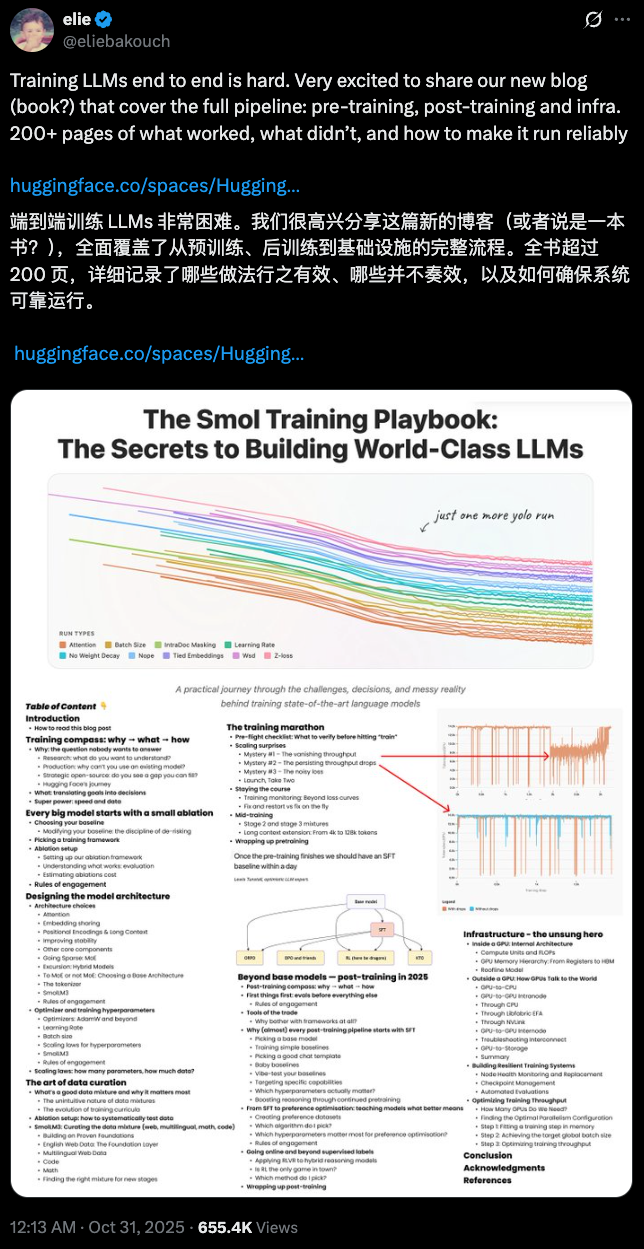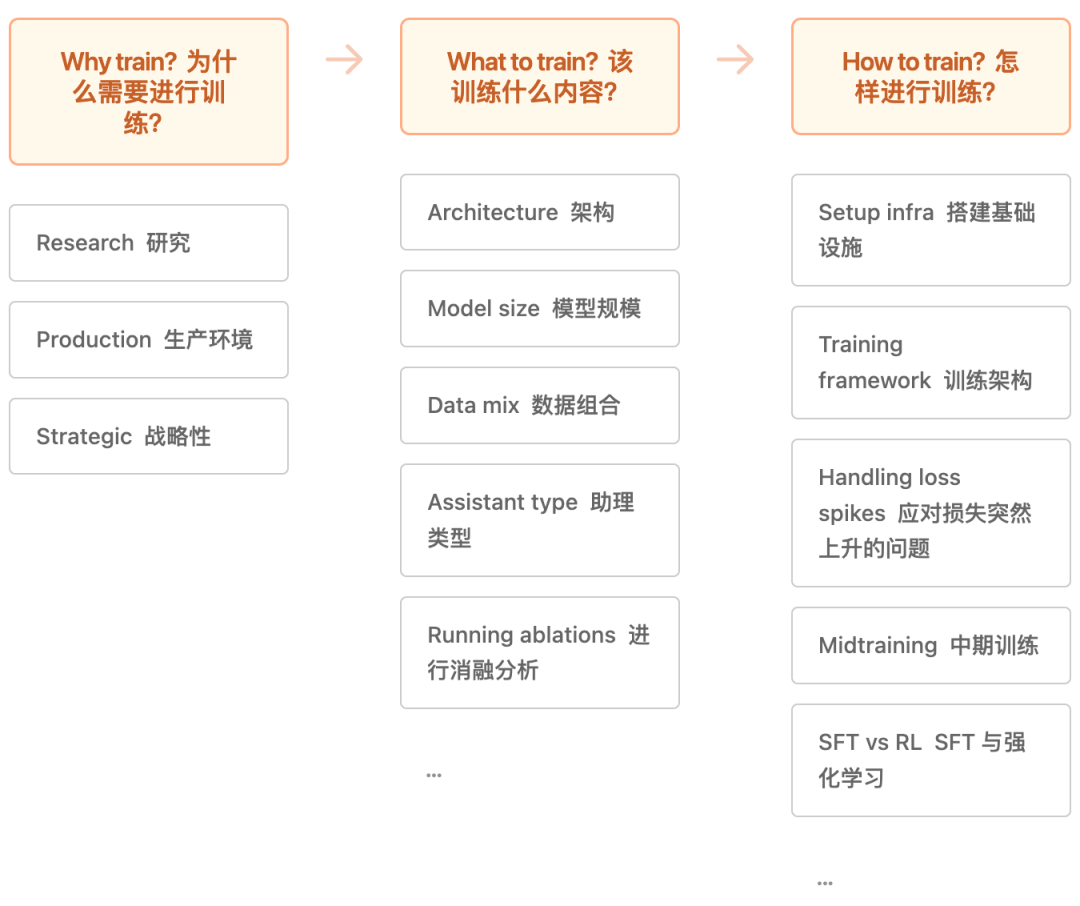214-Page Internal Guide: *Smol Training Manual – Secrets to Building World-Class LLMs*

What It Really Takes to Train a High-Performance LLM Today
Published research looks neat and logical:
A carefully designed architecture, curated datasets, and adequate compute yield ideal results.
Papers present perfect experiments, clean ablation studies, and “obvious” decisions — viewed with hindsight.
Reality is messier:
They rarely capture 2:00 a.m. data-loader debugging, the shock of sudden loss spikes, or tracking down a hidden tensor-parallel bug that has sabotaged weeks of work. In truth, the process is full of trial-and-error and discarded ideas that never make it to print.
Recently, Hugging Face released a 214-page internal manual — Smol Training Playbook: The Secrets to Building World-Class LLMs — detailing real-world challenges and decision-making complexities in training cutting-edge models.
It drew over 655.4K views in one day.

Original link: https://huggingface.co/spaces/HuggingFaceTB/smol-training-playbook
Below is a condensed, practical strategy from Hugging Face’s blog and their SmolLM3 training experience. For full insights, read the original post.
---
Phase 1 — Decide Before You Train
Training a high-performance LLM is high-risk. Answer three strategic questions first:
- Why train?
- What to train?
- How to train?
Avoid burning compute when you shouldn’t train at all.

Step 1 — Clarify Goals (Why → What)
Ask: Can existing models solve the problem with prompt engineering or fine-tuning?
Pretraining from scratch usually makes sense only for:
- Research — exploring architectural innovations
- Production — specialized domains or constraints (e.g., edge deployment)
- Strategic open source — filling ecosystem gaps (e.g., deployable small models)
Example:
Hugging Face’s goal for SmolLM3: Fill the gap for powerful, efficient, small on-device models → picked a dense 3B Llama-style architecture.
---
Step 2 — Use Ablation Experiments to De-Risk
LLMs behave non-intuitively. Only ablation testing can confirm the right decision.
Effective ablation requirements:
- Iterate quickly
- Strong discriminative power
- Change one variable at a time
Why strict?
Complex interactions mean multi-variable changes mask causal effects.
Adopt each proven change into the baseline, then test another — yielding cumulative, explainable, reversible gains.
Follow the de-risking principle:
Only adopt architecture or hyperparameter changes backed by evidence of improved performance or measurable engineering gains.
> Gains include:
> - Better target capabilities
> - Faster inference
> - Lower memory usage
> - Greater stability — without hurting core metrics
Cost reality:
For SmolLM3, ablations + debugging consumed >50% of total cost (161,280 GPU·h).
The team tested only modifications with strong potential impact.
---
SmolLM3 Key Architecture Choices
- Attention: GQA (Grouped Query Attention) → compresses KV cache, improves inference efficiency with minimal quality loss.
- Embedding: Shared input/output embeddings → saves parameters, reallocates budget to deeper networks for small model gains.
- Positional encoding: RNoPE (alternating RoPE and NoPE) → retains short-context strengths, improves long-context generalization potential.
- Data: Intra-document masking → blocks cross-document attention; stabilizes training; improves long-context handling.
- Hyperparameters:
- Optimizer: AdamW (stable, reliable)
- LR schedule: WSD (Warmup–Stable–Decay) → more flexible than cosine decay and adjustable mid-training.
---
Phase 2 — Build Pre-Training Foundations
Data defines the model’s abilities.
Use a multi-stage curriculum:
- Early: Broad coverage, high-volume general datasets → baseline distribution.
- Later (LR decay phase): Inject small amounts of high-quality data (e.g., Stack-Edu, FineMath4+) → shapes final behavior in low-LR steady learning without overwriting earlier skills.
Multilingual Planning Starts with the Tokenizer
Metrics to measure:
- Fertility: avg. tokens per word (lower = better efficiency)
- Continued-word proportion: how often common words get split (lower = better)
SmolLM3 choice: Llama-3.2 tokenizer — balanced multilingual coverage, reasonable size, fast training (minimal redundant tokens).
---
Phase 3 — Scaling Up
At large scale, failures and bottlenecks are inevitable.
Case: 11T-token training for SmolLM3
1. Throughput & Data Bottlenecks
- Initial issue: Throughput drop traced to shared FSx storage eviction causing missing pages → IO jitter.
- Fix: Download full 24 TB corpus to each node’s local NVMe RAID (`/scratch`) → stable high throughput.
- Secondary issue: Throughput decline with step count → Indexed nanosets dataloader slowed.
- Fix: Switched to TokenizedBytes loader → raw byte splits, avoided hot-index bottlenecks.
Lesson: Address physical bottlenecks first — IO/storage, then loader complexity — use shortest-path fixes.
---
2. Subtle Tensor Parallel Bug
At ~1T tokens, evaluations lagged.
Systematically ruled out data, optimizers, LR schedules, evaluation pipeline.
Root cause: Each TP rank reused the same random seed → correlated weight initialization, reduced effective representation space.
Fix: Restart at 1T tokens, giving each TP rank an independent seed.
Lesson: Even tiny settings can scale into big problems.
---
Phase 4 — Post-Training for Polished Behavior
Pre-training = raw capabilities.
Post-training = stable, controllable assistant behavior.
SmolLM3’s Hybrid Reasoning
- `/think` → chain-of-thought reasoning
- `/no_think` → direct conclusions
---
Post-Training Steps
- Mid-Training (Continued Pre-Training)
- Add large-scale distilled reasoning data → strong reasoning patterns before instruction alignment.
- Boost: reasoning benchmark ×3.
- SFT (Supervised Fine-Tuning)
- Loss on assistant tokens only → focuses on answer quality
- Avoids question continuation habit
- Preference Optimization
- Align style and trade-offs with human preferences
- Use lower LR (≈×0.1 SFT LR) → avoid catastrophic forgetting
- RLVR (Reinforcement Learning via Verifiable Rewards)
- Autonomously refine strategies when tasks are auto-verifiable
- Risk: reward hacking via long CoTs → mitigate with length penalties
---
Final Sequence:
- Mid-training → build reasoning foundation
- SFT → basic assistant behavior
- Preference optimization → human alignment
- RLVR → fine-grained improvement
- Applied with hybrid reasoning control across all phases.
Guiding principle:
Design every signal for controllability & verifiability → stronger capabilities and practical usability.
---
Broader Workflow Link
These engineering lessons parallel AI content creation workflows:
Platforms like AiToEarn官网 combine:
- AI generation
- Multi-channel publishing
- Analytics
- Model ranking
Allowing deployment & monetization across Douyin, Kwai, WeChat, Bilibili, Xiaohongshu, Facebook, Instagram, LinkedIn, Threads, YouTube, Pinterest, and X.
Efficiency and precision — crucial in both LLM training and large-scale creative production.
---
In summary:
Successful LLM training demands:
- Strategic decisions pre-training
- Disciplined ablations
- Robust data handling
- Precise scaling fixes
- Targeted post-training
And the wisdom to know: sometimes, the most important choice is not to train at all.


